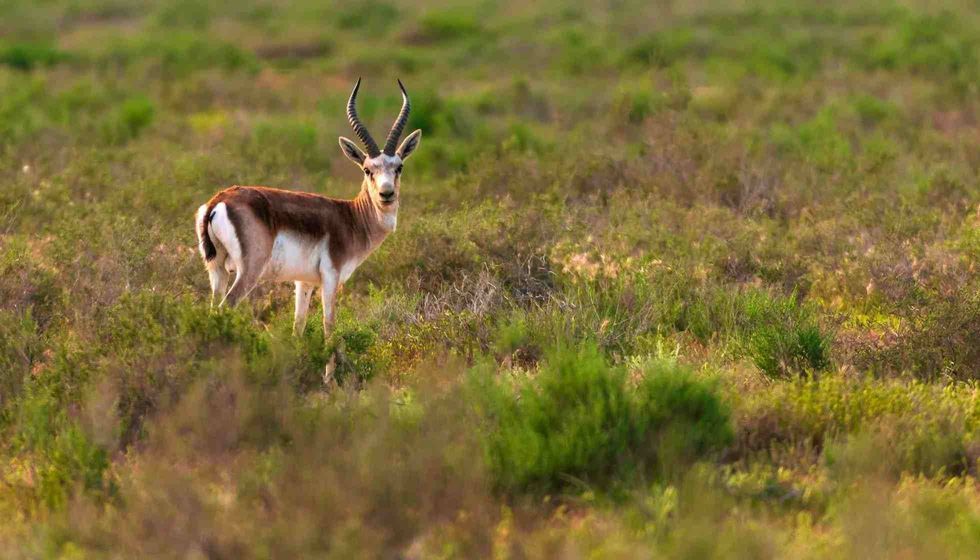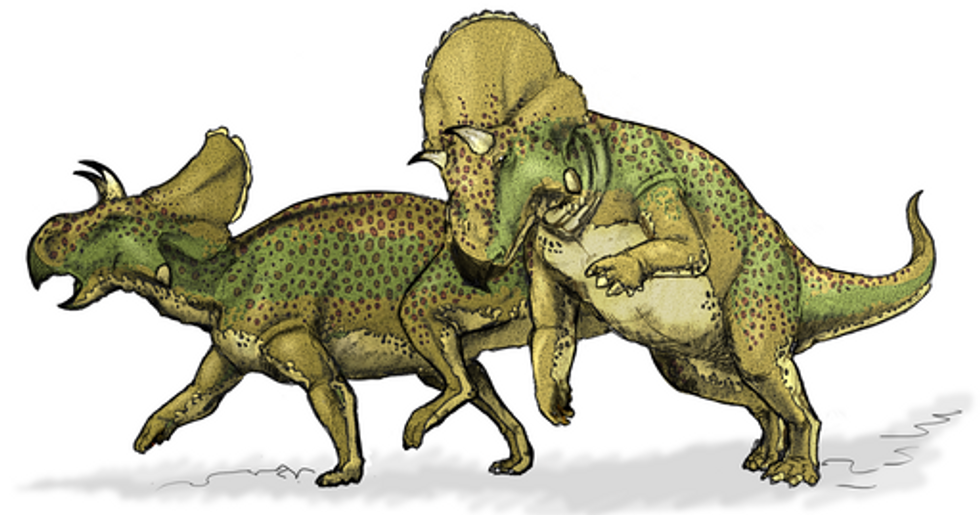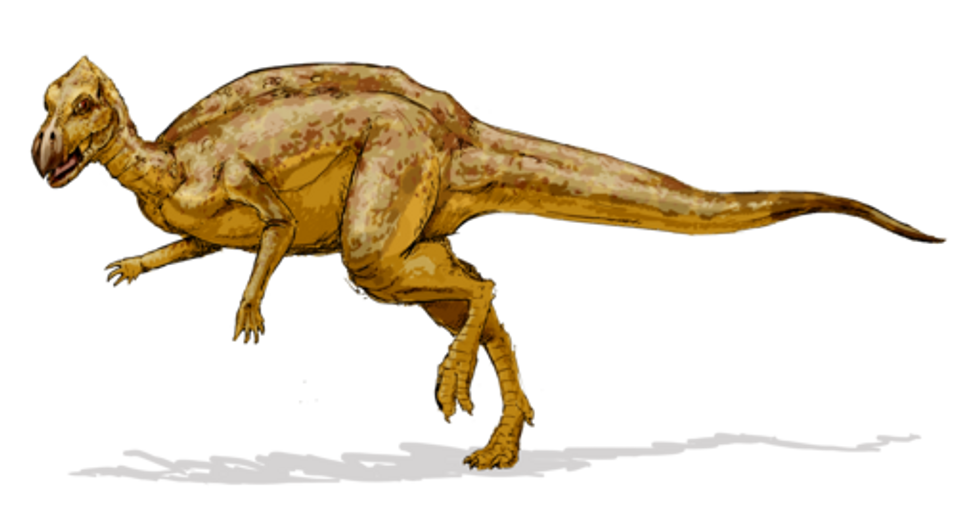Goitered gazelle is one of the six species of Asian gazelle that belongs to the genus Gazella. They are also known as black-tailed gazelles (Gazella subgutturosa) and Persian goitered gazelles. They are commonly found in Central Asia.
One of the subspecies known as Arabian sand gazelle is found in Syria, Saudi Arabia, Oman, and the Persian Gulf. They are usually found in small family groups consisting of five individuals.
In winter, they form larger groups. Large herds cover long distances seasonally. They can run at a speed of 18 mph (29 kph).
The breeding season of this species occurs from September to December. During the mating season, the neck and throat of the males become enlarged due to secretions from the inguinal and preorbital glands.
After mating, the gestation period of the females lasts for five to six months. Then the females give birth to one to four calves. The calves are born in April and May.
The International Union for Conservation of Nature or IUCN Red List has listed goitered gazelle as Vulnerable. The destruction of habitat, climate change, and illegal hunting are a few of the threats encountered by these species.
If you liked reading about goitered gazelle facts for kids, then do check out reindeer facts and key deer facts!
Goitered Gazelle Interesting Facts
What type of animal is a goitered gazelle?
A goitered gazelle (Gazella subgutturosa) is an antelope that belongs to the Bovidae family. It is one of the six species of Asian gazelles belonging to the genus Gazella.
What class of animal does a goitered gazelle belong to?
It belongs to the class Mammalia of animals.
How many goitered gazelles are there in the world?
The total population of this species is estimated to be around 42,000-49,000.
Where does a goitered gazelle live?
Goitered gazelles (Gazella subgutturosa) are commonly found in Central Asia, particularly in the southern part of the Arabian peninsula. The goitered gazelle range extends from the south of Kazakhstan and Mongolia to the northwestern part of China.
In central Asia, they mostly reside in Uzbekistan, Kyrgyzstan, Tajikistan, and Turkmenistan. A large population of this species is also found in Iran.
They also inhabit Afghanistan, Pakistan, and some parts of Turkey. The Arabian sand gazelle, one of the subspecies, is found in Syria, Saudi Arabia, Oman, the United Arab Emirates, and the Persian Gulf.
What is a goitered gazelle's habitat?
The preferred habitat of this species includes deserts and semi-arid steppes. The desert habitat comprises extreme temperature conditions along with scanty rainfall. They can survive in areas without vegetation.
They are also known to graze on the edges of cultivated land. They are also found in grasslands, shrublands, gravel plains, and on the foothills of mountains.
In winter, they take shelter in mountain canyons and deep valleys. They also migrate seasonally in large herds, especially in winter. They are found up to an elevation of 11482 ft (3499.7 m) from sea level.
Who do goitered gazelles live with?
They prefer to live in close family groups comprising of five individuals. They are also known to form larger groups consisting of around 100 individuals. Their groups are commonly known as herds. During the breeding season, female gazelles and young form groups of 10-30 individuals.
How long does a goitered gazelle live?
This species has an average lifespan of six years in the wild similar to white-tailed deer. In captivity, it can live up to 20 years of age.
How do they reproduce?
Goiterred gazelles are usually polygamous in nature, where the male mates have multiple mating partners throughout their lives. The breeding season of this species occurs from September to December. These species breed once a year.
During the mating season, the males exhibit courtship displays, mark their territory by defecation, and chase the females into their breeding ground. The gestation period or pregnancy in females lasts for five-six months. After mating, the females give birth to one to four young gazelles.
They are usually born in April and May. The young are weaned by the female up to six months of age. Both males and females attain reproductive maturity, on average, at one year of age.
What is their conservation status?
The International Union for Conservation of Nature or IUCN Red List has listed goitered gazelle (Gazella subgutturosa) as Vulnerable. The destruction of habitat, climate change, and illegal hunting are some of the threats encountered by this species and are responsible for their dwindling population.
Goitered Gazelle Fun Facts
What do goitered gazelles look like?Goitered gazelles exhibit sexual dimorphism where the males and females differ in their appearance. Males are slightly larger than females. Their coats are of different colors such as light brown, yellow, red, or gray.
Gazelles have slender legs, dark eyes, and long ears. The horns of the males are longer than that of females. The horns have an outward curvature at the distal end.
Many of the females do not possess horns. The enlargement of the neck and throat in males during the breeding season happens due to the swelling of the preorbital and inguinal gland.
It is one of the distinguishing features which set them apart from other gazelle species. They also have a short tail that is brown or black in color. Hence, they are also known as black-tailed gazelles (Gazella subgutturosa).

How cute are they?
Their cuteness usually stems from their appearance. The presence of horns, slender legs, short tails, and dark eyes make them look cute similar to fallow deer who are known to be extremely gorgeous.
How do they communicate?
They usually communicate through a range of vocalizations. Their calls are mainly a hissing sound, low-pitched grunts, and moos. Both adults and young gazelles communicate through low-pitched grunts.
The females communicate with their calves through low-pitched calls and the young respond through a series of moos. The male's scent marks their territories and produces a wheezing sound on the breeding ground. They usually hiss before they start running.
How big is a goitered gazelle?
Goitered gazelles are 37-49.6 in (93.9-126 cm) in length. They are slightly larger than dorcas gazelles who are about 35.4-43.3 in (90-110 cm) in length.
How fast can a goitered gazelle run?
It can run at a speed of 18 mph (29 kph).
How much does a goitered gazelle weigh?
Goitered gazelle's weight varies in both males and females. The males weigh around 44-94.7 lb (20-43 kg) and the females weigh around 39.6-72.7 lb (18-33 kg) similar to tufted deer.
What are their male and female names of the species?
Scientists do not have specific names for male and female goitered gazelles. They are commonly referred to as male goitered gazelles and female goitered gazelles.
What would you call a baby goitered gazelle?
A baby goitered gazelle is known as a calf.
What do they eat?
They are herbivorous mammals and mostly feed on a large variety of grasses. The goitered gazelle diet also includes fruits, cotton, maize, wheat, and dates. They also feed on legumes, halophytes, ephedras, and gourds. In captivity, they are fed oats, alfalfa, and grain pellets.
Are they dangerous?
No, they are not dangerous. Some of the gazelle species are aggressive in nature and guard the females in their breeding ground. However, goitered gazelles aren't known to be aggressive. Though the males are territorial in nature during the mating season.
Would they make a good pet?
No, they do not make good pets. These animals require large space to run and stay active. It is also illegal to own these animals as pets in many countries. However, they are found in zoos and national parks.
Did you know...
Their slender legs have strong muscles near the thigh joint. These muscles provide them additional support while they are running at high speed.
Temperament of the goitered gazelle
Males become territorial and defensive during the breeding season. They run at high speed to avoid predators.
What are the adaptations of a gazelle?
Gazelles are predominantly diurnal and graze during the daytime. However, they become nocturnal in places where they encounter threats. Their coats become thicker during the winter season to provide protection against the freezing temperatures. They can survive without water and their water requirements are met from the plant materials.
Here at Kidadl, we have carefully created lots of interesting family-friendly animal facts for everyone to discover! For more relatable content, check out these saiga antelope facts and Mexican wolf facts for kids.
You can even occupy yourself at home by coloring in one of our free printable goitered gazelle coloring pages.










